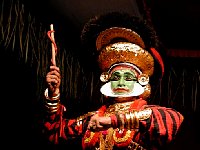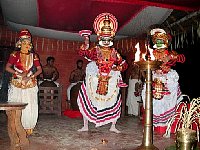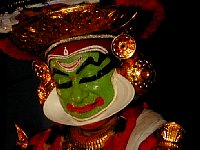|
|
|
|
|
|
|
|
|
|
|
|
|
|
Koodiyattam is recognized by the
UNESCO as one of the masterpieces of the oral and
intangible heritage
of humanity. The Koodiyattam tradition of enacting
classical Sanskrit dramas,
is
closely tied to Kerala's Hindu temples. It is a comprehensive theatre
form that has existed since before the tenth century AD and is India's
oldest theatre to have been continuously performed. Koodiyattam
has the same delight in nuance and hidden shades of meaning in
metaphors and delicate implications which is the hallmark of so much of
Sanskrit literature.
There is clear evidence of efforts to
reform Koodiyattam by one king, Kulashekhara
Varman by the 9th to the 10th century A.D. As such reforms give
rise to the supposition of a long-standing tradition, literary sources
assume that Koodiyattam has a continuous history of at
least 1000 years. This makes Koodiyattam the
oldest surviving form of Sanskrit theatre.
click any image to enlarge it !
 |
 |
 |
|
Here we find also the meeting of the two world views: the patriarchal and matrilineal. The Chakyars are the male actors and chief custodians of the art, while sharing the stage with the Nangyars, women of matrilineal households and their men folk, the Nambiar drummers. While the Chakyars are said to be of Aryan origin and therefore probably carriers of Sanskrit learning, the Nangyars are local and their inclusion represents thus a harmonious fusion between two distinct cultures. While Koodiyattam's Vedic/Sanskrit origins have been preserved and regarded as a sacrilege, the actor's independent interpretation of the text has simultaneously adapted to regional tastes until Koodiyattam has been assimilated as a supremely art of Kerala. The vigor of the folk art roots of Koodiyattam and Koothu may explains to a large extent that this art form is still alive. |
|
|
|
|
|
To be successful in this the actor must be well-versed in what the Natyashastra, the great treatise on dramaturgy in Sanskrit by Saga Bharata, written sometime between 2nd century B.C. and 2nd A.D. , describes as the four main Abhinayas (abhinayam=the art of dramatic expression through words, facial expressions or gestures) All these techniques help to explore each character's inner complexities. |
the training
|
angika =
dramatic expression with the body (hand gestures or mudras, facial movements) satvika = actors' inner identification with the character that may be marked by involuntary physical reaction like tears, perspiration and fainting vachika = ritualistic teh use of voice aharya = makeup (symbolic use of colour) and costume |
| Ammanur Chachu Chakyar Smaraka Gurukulam, Irinjalakuda, Thrissur District | |
| NatanaKairali, Irinjalakuda,
Thrissur District a research and performing centre for traditional arts, that has been playing a significant role in the conservation and popularization of Koodiyattom for more than two decades. Natana Kairali with it's dynamic founder-director Gopal Venu, himself an actor and trained in Koodiyattam from guru Ammannur Madhava Chakyar and Ammannur Paremeswara Chakyar, is also involved in propagating the art form outside the country by organizing workshops and staging the Sanskrit theatre in various countries. |
|
| Kerala Kalamandalam. Cheruthuruthy, Thrissur District | |
| Mani Madhava Chakyar, Likkadi, Thiruvananthapuram District |
Kuttu, Koothu
| Koothu is a mono act in which a single actor represents the role of all the characters. He expounds puranic stories, drawing parallels from contemporary life in order to emphasis a point or relate a moral from the stories he is narrating. |
| Nangiar
Koothu is an offshoot of Kutiyattam that has
captured the imagination of people in recent times. is performed solo
by a woman actress. The stories she enacts are taken from the the text Sree
Krishna Charitam, depicting the life of Lord Krishna.
Usha Nangiar, a disciple of Ammanur Madhava Chakyarm has already become synonymous with this art form. Kunjipaalykutty Nangiaramma is another well known contemporary actress of Nangiar Koothu. |
Chakyar (Prabandham) Kuttu
| Chakyar or Prabhandam Kuttu, a solo performance, is another offshoot of Koodiyattam. The character represents the vidushaka (fool, clown), poking fun at Kerala society, using the colloquial language Malayalam. The name of the art form refers to the community of the actor respectively to the use of the prabhandas, literary works in Sanskrit for dance-drama. as a basis for his narration. |
Copyright
© 2001-2003 Prem
Manasvi. All rights reserved.
WebDesign
& WebHosting: nalukkettu consulting
mykerala.net